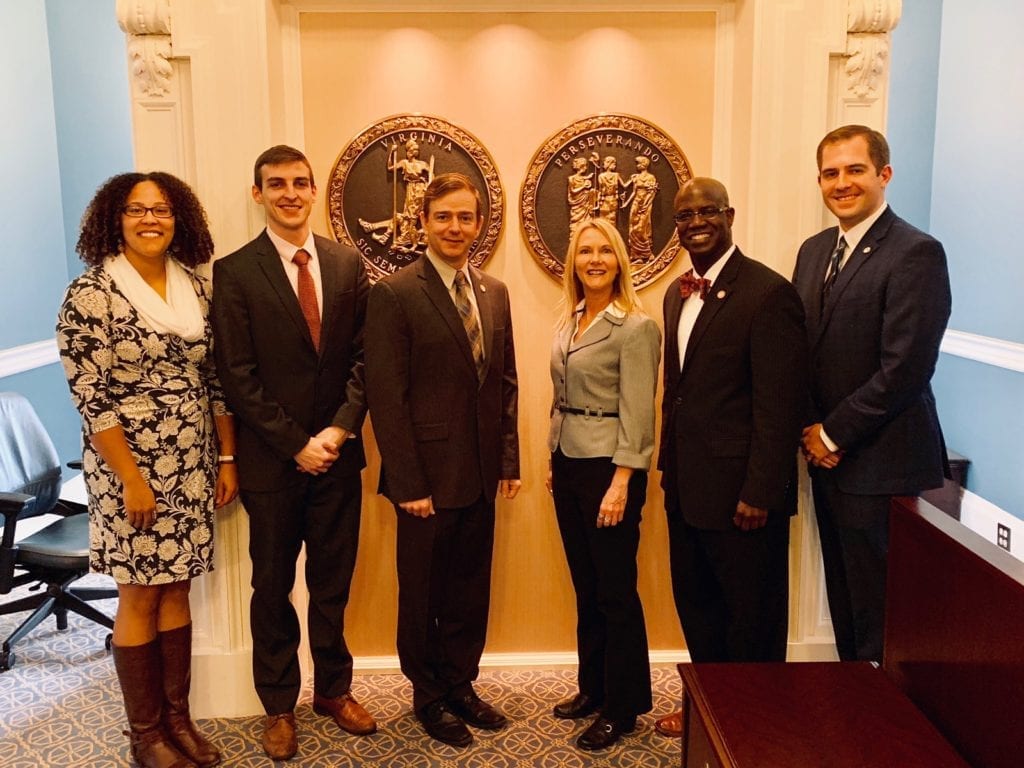Photo: VACo participated in an important meeting on veteran suicide and access to veteran resource officers. Pictured from left to right – Virginia Assistant Secretary of Veterans and Defense Affairs Leslie Frazier; NACo Legislative Associate Austin Igleheart; Delegate Bob Thomas; King George County Supervisor Ruby Brabo; Virginia Secretary of Veterans and Defense Affairs Carlos Hopkins; and VACo Director of Intergovernmental Affairs Jeremy Bennett.
VACo staff recently attended a meeting with Secretary of Veterans and Defense Affairs Carlos Hopkins, King George County Supervisor Ruby Brabo, Delegate Bob Thomas, and representatives of the National Association of Counties and National Association of County Veteran Service Officers to discuss veterans’ services and suicide prevention in Virginia. The skills, leadership, and experience that veterans carry often benefit the institutions and communities in which they work and reside. Making sure they have access to the benefits and services owed to them is important to ensure quality of life for veterans, their families, and their communities.
According to a June 2018 Report from the U.S. Department of Veterans Affairs (VA) National Center for Veterans Analysis and Statistics, Virginia’s Veteran population exceeded 725,000 individuals distributed across every locality in the Commonwealth. This constitutes approximately 3.6% of the total veteran population in the United States and ranks Virginia as the 8th state with the most veterans residing within it. The U.S. Department of Veterans Affairs expended more than $5.9 billion in FY 2017 on compensation and pension benefits, education and vocational rehabilitation/employment, and medical care for veterans within the state.
Though most service members successfully readjust to life outside of the military, some individuals may need additional supports to help with this transition or challenges later in life. According to the September 2018 VA National Suicide Data Report from the Office Mental Health and Suicide Prevention, the suicide rate was 1.5 for times greater for veterans than for non-veterans (adjusting for age and gender). Though Virginia Veteran Suicide rates are lower than the national and regional veteran suicide rates, they were still significantly higher than the national suicide rate.
One way to possibly reduce veteran suicides would be to increase access to and awareness of services and supports available to veterans through the VA, state, and local government. According to the Suicide Data Report, suicide rates for veterans were halved for individuals receiving care. The Virginia Department of Veterans Services (DVS) currently employs veterans service representatives (VSR) in 34 regional offices across the State, to assist veterans to understand and apply for any VA benefits to which they may be entitled and to gather any evidence needed and to submit a Fully Developed Claim on their behalf. Additionally, some of these offices have coordinated with localities in their respective regions to provide mobile office hours, the most recent schedule of which can be found here.
If you’re a veteran or service member in crisis or you’re concerned about one, the VA’s Veterans Crisis Line is available 24 hours a day, 7 days a week. More information on mental health support services and data provided through the VA can be found here.
VACo Contact: Jeremy R. Bennett
Photo: VACo participated in an important meeting on veteran suicide and access to veteran resource officers. Pictured from left to right – Virginia Assistant Secretary of Veterans and Defense Affairs Leslie Frazier; NACo Legislative Associate Austin Igleheart; Delegate Bob Thomas; King George County Supervisor Ruby Brabo; Virginia Secretary of Veterans and Defense Affairs Carlos Hopkins; and VACo Director of Intergovernmental Affairs Jeremy Bennett.

